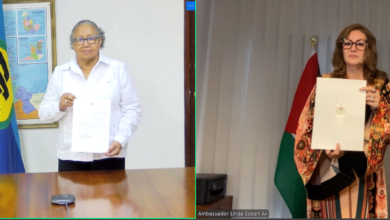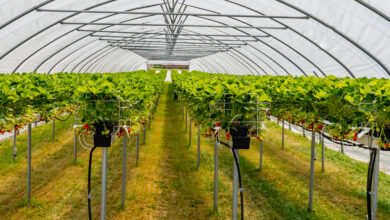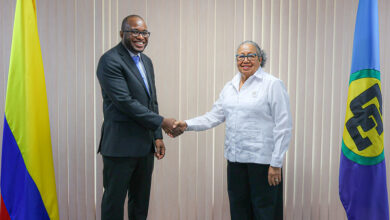CARIFESTA is returning to the mainland in August 2003, in a year when both host country –Suriname- and its CARICOM sister states have a lot to commemorate – CARICOM marked its 30th anniversary and Suriname commemorated the 140th anniversary of slavery abolishment, 150 years of Chinese immigration, 130 years of Indian immigration and 115 years of Indonesian immigration, the cultural richness of the Caribbean will fall in the spotlight.
“What we’re going to do with CARIFESTA this year is celebrate our achievements, especially the achievement of freedom. Every country that’s participating will exhibit its achievements in its own way,” said Henk Tjon, the artistic mind behind CARIFESTA VIII.
The one-week event that presents the Caribbean at a glance blasts off on August 24th. CARICOM Member States, as well as Caribbean nations that are not members of this economic association and states invited from the Far East, Europe and North America are set to take part. And besides exhibiting their art, nations will take pride in giving meaning to the event’s theme “Cultural Diversity.” Focus will be placed on the Indigenous People. “They are our region’s first inhabitants and the first to fight for their freedom and sign peace accords with the colonial oppressors,” said Tjon.
Known for its rich cultural and ethnic diversity, Suriname is home to five tribes of Indigenous People. The Caraibs and the Arowaks live in the coastal area and deep in the southern part of the country, near the border with Brazil live the Trio, the Wayana and the Akurio.
To experience how these proud people live, one could take an exciting trip to their villages, spending the night sleeping in a hammock in a hut – eco-tourism style -. For CARIFESTA VIII the organisers thought they would bring the experience closer to home.
LIVING EXHIBITION
Suriname has gone all out to pay homage to the Indigenous People. “We have built an Amerindian village, where ours and those that visit from other countries will be accommodated,” said Chas Warning, member of the Committee charged by Suriname’s Government with organizing CARIFESTA Vlll.
This village has been constructed in Palmentuin, a historic garden of hundreds of century old king palm trees. While in itself a tourist attraction, this village is also meant to perform the task of catalyzing CARIFESTA activities in other locations.
“The Indigenous People will live in this village, in their own huts and people can actually experience them doing the things they have been doing for centuries: baking cassava bread, making pottery. The village will be open all night, so after the other activities in the other locations are over, it will serve as a hospitality centre where the party goes on,” he informed.
Warning explained that the goal of focusing on the indigenous segment of the Caribbean population is to make it clear that these people deserve recognition. “They have suffered. Not that others didn’t, but you have got to start somewhere in expressing respect to them,” he said. He added that the process of emancipation, as it is taking place in other parts of the world, demands going beyond just words.
According to Henk Tjon placing the focus on the Caribbean’s first inhabitants was the intention from the beginning, back in 1972 when the event was staged in Guyana. “Then already the Indigenous People were the only ethnic group that was part of CARIFESTA. They were there, but unfortunately their presence wasn’t highlighted enough. There was never really a concept for their participation,” he said.
In 1992, when CARIFESTA IV was hosted in Trinidad and Tobago, the twin-island-state gave the Indigenous People attention. It so happened that it was at the time when the world marked 500 years since Columbus discovered the “New World”, America.
“Only six of the 30 countries that took part in CARIFESTA then included the Indigenous People in their delegations. Suriname has always done that. Now that we are hosting the event, I thought we have to include a concept for the Indigenous People,” said Tjon.
Tjon explained that the Indigenous People village will present these people at their best. “You’ll see all the different tipi the various Amerindian tribes live in. The Wayana, the Trio, all of them will come from their villages in the interior, from Guyana and French Guiana. Belize will come with its Maya and so forth. It will be a living exhibition,” he said. “History” makes the Indigenous People deserve that spotlight.
The history of the plantation and the slavery period in general is not just the history of the Europeans and the Africans. It is also the history of the Amerindians.
GEMS
This history will be celebrated during CARIFESTA VIII. Indeed, the Indigenous People are set to enjoy centre stage during CARIFESTA VIII. “Of course the other ethnic groups will also be there. The Indians, the Indonesians, the Chinese… They will all be there. The Maroons –descendents of runaway slaves- too. They will be the gems in the entirety,” he said.
As a matter of fact, these “gems” that can easily represent Africa a continent away, are expected to put up a never before seen cultural performance during CARIFESTA VIII, interfacing with visitors from Ghana – where most slaves brought to Suriname were from – and with a “Granman” (chief) of the Jamaican Maroons. Maroons are descendents of slaves who would rather runaway into the forest than spend their life in the captivity of the plantation owners. In Suriname and Jamaica these Maroons started their own villages in the interior and their descendants still live there, determined to cling on to the traditions their ancestors brought from Africa.
Suriname knows six Maroon tribes, all of whom still live in the areas close to the rivers in the interior where their ancestors started their villages. The N’Djuka (also called Aucans) live near the Tapanahony, Cottica and Commewijne rivers. The Saramaccans live near the upper-Suriname river. These are the biggest tribes. There are also the Paramaccans (near the Marowijne river), the Matuari (upper Saramacca river), the Boni (Lawa) and the Kwinti (lower Saramacca river). It is estimated that some 40,000 Maroons live in the interior.
Tjon is excited: “We’re flying to Asidonhopo –the main Saramaccan village, where the Granman lives-,” he said. “The Granman from Jamaica will be the guest of honour. Imagine the welcome he’ll get when he arrives in the villages. That will be a spectacle by itself. You’ll see things not many get to experience. Not even Discovery Channel and National Geographic offer that.”
But, he added, the main focus will be on the oldest inhabitants of our region. The Indigenous People will take advantage of the opportunity to jointly present their heritage. “They will have their own programme, including their traditional rituals. They’ll have what we call in Suriname ‘puru blaka,’ a mourning ritual some also call epakadono. When that will take place it will go on all night. It will be great.”
Tjon foresaw that the theme of CARIFESTA VIII will become total reality in those six days in Suriname. “It will be a fantastic event, especially for tourists,” he said.





